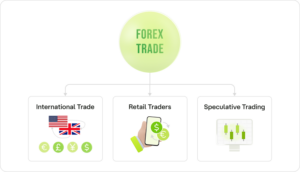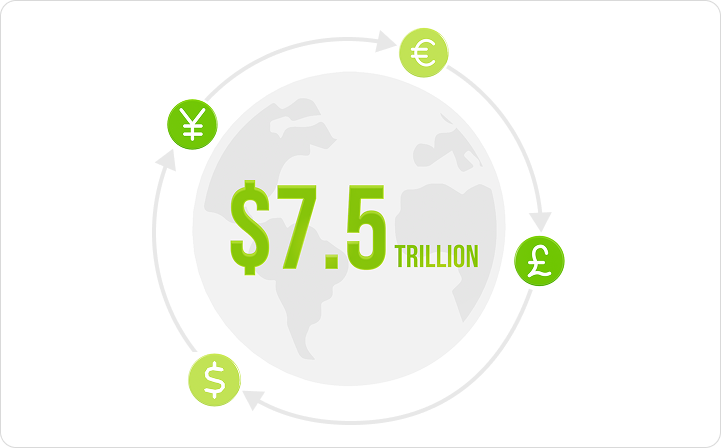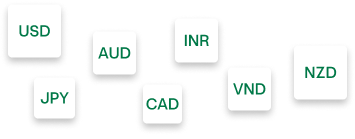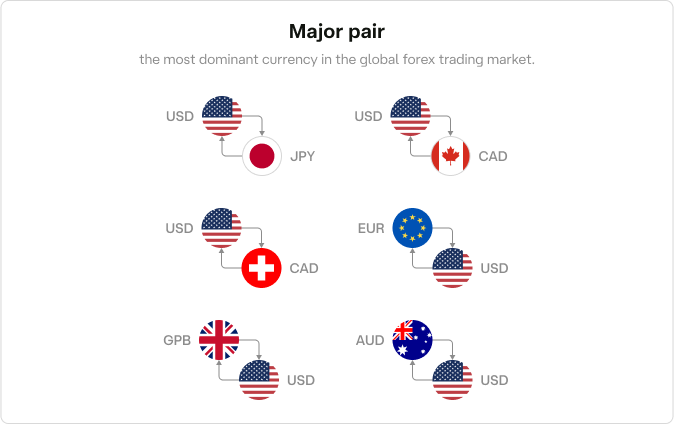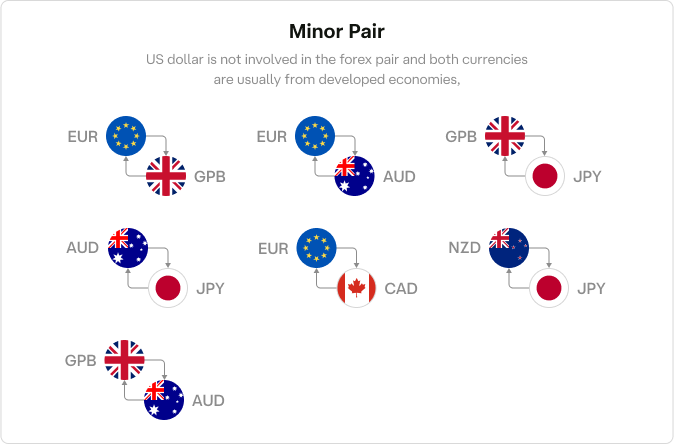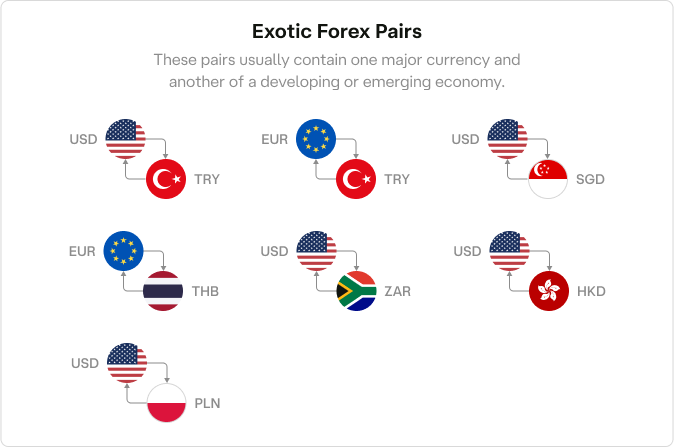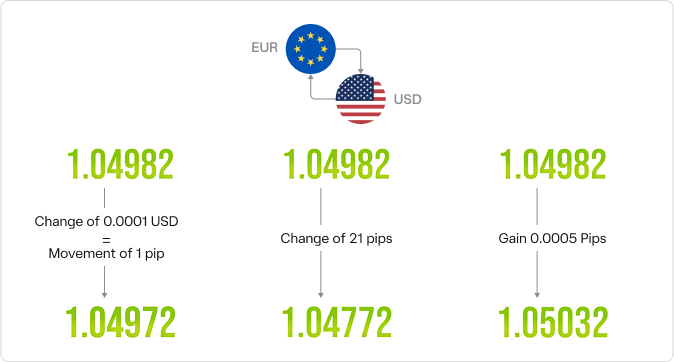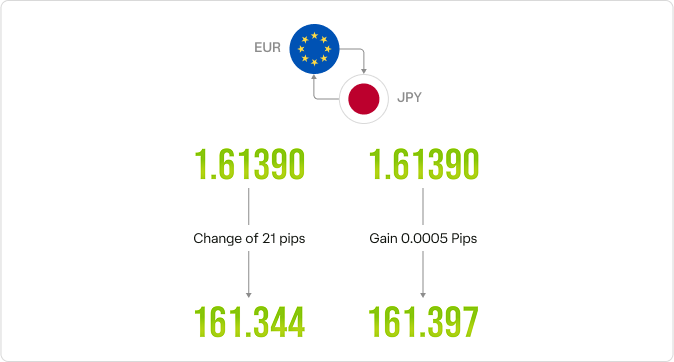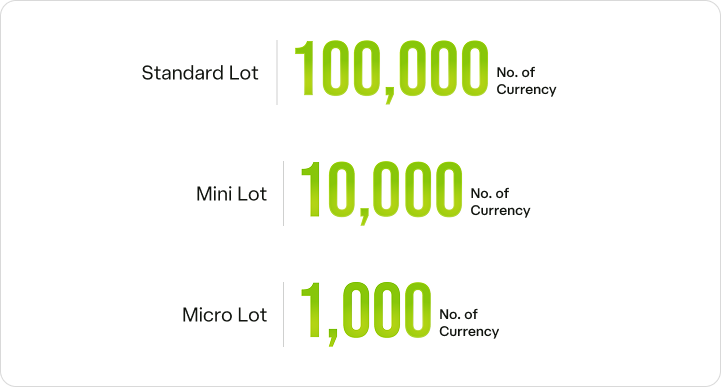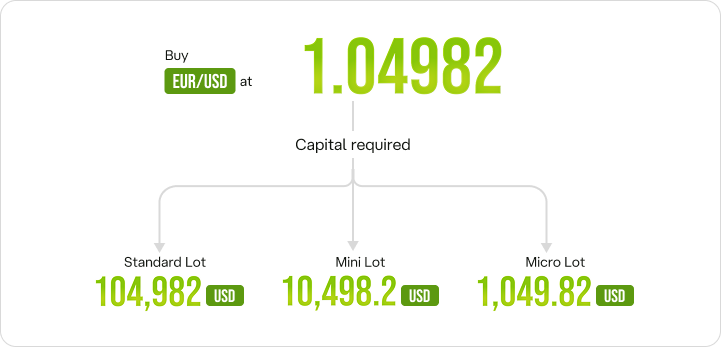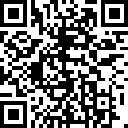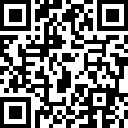Introduction
Foreign exchange, popularly known as forex or FX, forex trading is converting one currency into another. Anyone, including central banks, corporations, or individuals, can trade forex.
Forex trade is crucial as it facilitates international trade between countries and cross-country investments. Retail traders can also trade currency pairs to earn from their movement. Speculative traders never take delivery of the physical currency.
Since one currency trades against another, some of the most traded forex pairs include:
- GBP/USD – British pound against the US dollar
- EUR/USD – Euro against US dollar
- USD/JPY – US dollar against Japanese yen
- USD/CHF – US dollar against Swiss franc
(We will discuss forex pairs in detail later in this chapter)
Forex market structure and forex trading timing
Unlike global stock markets, the forex market lacks a centralised exchange for trading currencies. Instead, transactions happen : one party directly sells currencies to another party.
Anyone can trade forex pairs using a desired broker that deals in currency pairs.
The world has four primary forex hubs: London, New York, Tokyo and Sydney. Thus, the forex market is open around the clock – from around 21:00 or 22:00 (UK time) on Sunday to 21:00 or 22:00 (UK time) on Friday, every week. This time varies by an hour due to daylight savings time changes in the UK, US and Australia.
When trading in one forex hub ends, another continues, thus making trading feasible for almost around the week (except for the weekend).
Open times (in GMT, Monday to Friday) of the four markets are the following:
London: 8 am to 5 pm
Tokyo: 12 am to 9 am
Sydney: 8 pm to 5 am
New York: 1 pm to 10 am
However, trading volumes might vary during some hours, as London and New York often handle higher volumes of orders than Tokyo and Sydney.
The size of the forex (FX) market
The forex market is massive compared to stocks and bonds. Traders exchange nearly worth of currencies daily worldwide, far surpassing the daily volumes of the New York Stock Exchange, London Stock Exchange, and Tokyo Stock Exchange.
The average share of trades in each of these top currencies is the following (according to the 2022 BIS Triennial Central Bank Survey):
- US dollar (USD): The most dominant currency in the forex market, involved in 88% of all trades globally.
- Euro (EUR): The second most traded currency, present in 31% of all trades.
- Japanese yen (JPY): Accounts for 17% of trades, making it the third most traded currency.
- British Pound (GBP):Maintains a 13% market share.
- Chinese Renminbi (RMB):The fifth most traded currency with a presence in 7% of the global trades.
(As two currencies are involved in every trade, the total sum of the forex trading market percentage of share of individual currencies is 200%, not 100%)
Forex market (FX) drivers
Forex trading is practical in international commerce and many other areas. However, traders also speculate on forex pairs to gain from the movements of one currency against another.
So, the question is: what drives the forex market changes?
- Some of the factors that impact the valuation of a currency against another are:
- Inflation rates
A low inflation rate increases a country’s purchasing power against other currencies and thus boosts its currency’s value. A higher inflation rate does the opposite. - Interest ratesThe
decision of any country’s central bank to change interest rates directly impacts the forex rates. A higher interest rate leads to a higher return to the lender in that currency. - Government Policies
Government policies: Economic policies, mostly involving decisions around debts, directly impact a country’s currencies. Decisions to suddenly take on debts often negatively affect the currency value. - Demand for imports and exports
The currency of any import-heavy country is often stressed and easily influenced by price fluctuations in the international commodities market. - Economic Outlook
Economic outlook: If a country’s economy is doing well with impressive growth figures, its currency often gains in terms of exchange rates.
Many other macroeconomic factors directly impact the movement of the forex market.
Understanding a forex symbol and pair
This guide has already introduced you to forex symbols and pairs. Now, let’s dive into them and understand them better.
Forex symbols
The three-letter symbols of currencies – USD, EUR, JPY, etc. – are based on the ISO 4217 standard. These alphabetic codes are recognised internationally as currency representations to enable clarity and avoid confusion.
There are standard codes for every government-recognised currency, from the major ones like the US dollar and euro to even the rare ones like Afghanis and Zambian kwacha.
The usually used alphabetic code contains three letters from the Latin scripts for every currency: The first two letters of the ISO 4217 three-letter code match the country code for the country name, while the third letter, when feasible, aligns with the currency’s initial letter.
- Based on the ISO 4217 standard
- Standard codes for every government-recognised currency
The following are some examples:
- USD: ‘US’ is the country code for the United States of America, while ‘D’ stands for dollar.
- JPY: ‘JP’ is the country code for Japan, while ‘Y’ stands for yen.
- INR: ‘IN’ is the country code for India, while ‘R’ stands for the rupee.
- VND: ‘VN’ is the country code for Vietnam, while ‘D’ stands for dong.
ISO 4217 also has three-digit numeric codes for every currency alongside the alphabetic codes. These numeric codes are usually used in countries that do not use Latin scripts and for computerised systems. Three-letter alphabetic codes are the standard for the general forex trading market.
Forex pair
In forex trading, two currencies are involved: a trade takes a position (buy or sell) in one currency against another. Each forex trading pair is represented by two currency symbols: EUR/USD, USD/JPY, and GBP/USD.
In a forex trading currency pair, the first currency is called the base or primary currency. The second currency is the quote or counter currency. The forex pair shows the value of the quote currency against the base currency, i.e., how much one unit of the base currency will buy of the quote currency.
In the pair EUR/USD:
- “EUR/USD = 1.04982” indicates one EUR is worth 1.04982 USD.
Forex currency pair categorisation: Major, minor and exotic
Theoretically, as a trader, you can exchange any currency against another as long as they are recognised globally. However, the reality is different.
Some forex pairs are widely traded, while others have limited trading volumes. None of the brokers list the available forex pairs worldwide; only the popular ones with tradable liquidity are often offered.
Major forex currency pairs
Most forex trading occurs with a few selected currencies called major forex pairs or majors.
However, there are no officially recognised forex pairs globally. The brokers or other local players instead characterise them. The six widely recognised majors that constitute over 80% of forex traders are:
All these forex pairs include the US dollar, the most dominant currency in the global forex trading market.
Minor forex pairs
If the US dollar is not involved in the forex pair and both currencies are usually from developed economies, then the pair is often called a minor currency pair. Such forex pairs are also often called cross-currency pairs or simply crosses.
Although there are no rules in such forex pair categorisation, most popular crosses tend to have the euro (EUR), British pound (GBP) or the Japanese yen (JPY). Some of the popular minor forex pairs are:
Exotic forex pairs
Some forex pairs are also categorised as exotics. These pairs usually contain one major currency and another of a developing or emerging economy. Such pairs are not traded often, but some traders tend to trade them to speculate on the economies of developing or emerging countries.
Some of the exotic forex pairs are:
Singapore, Poland, Hong Kong (and many other developed regions) currencies are also considered exotic as their economies are much smaller than those of the majors.
There are also some other region-specific forex pair categorisations. Although these regional pairs are rare, some traders tend to trade them.
Two of the such regional forex pairs are Australasian pairs or Scandinavian pairs. The Australasian pair is usually the Australian dollar vs New Zealand dollar (AUD/NZD). In contrast, the Scandinavian pairs are euro vs currency of any Scandinavian countries, like the euro vs Norwegian krona (EUR/NOK).
Understanding a ‘pip’
In the stock market, investors can quickly determine a company share’s value against a fiat currency by tracking the change in dollars, cents, or other currency units. However, a forex pair’s fluctuation can be minuscule.
A ‘pip’ is a tiny unit that usually measures the value fluctuation of a forex pair.
For the non-JPY majors, a pip is the fourth decimal point, representing 1 pip, while for JPY pairs, 1 pip is the second decimal point.
Let’s understand this with examples.
You might have already noticed that a forex pair usually has five decimal places (in non-JPY pairs).
So, if the EUR/USD = 1.04982, a change of 0.0001 USD on either side will represent a movement of 1 pip; if the value of the exact pair changes to 1.04772, then there is a movement change of 21 pips. Similarly, if the EUR/USD value changes to 1.05032, the pair gains 0.0005 pips.
Taking the example of a JPY-based pair, let’s say EUR/JPY is trading at 161.390. If the pair’s value changes to 161.344, it is a 25 pips change. Similarly, if the value of EUR/JPY touches 161.397, then there is a change of 7 pips.
What is a ‘lot’?
Traders track the movement of forex pairs in pips, so the unit change is tiny. They traditionally trade forex pairs in large batches called lots to make trading feasible.
A standard lot has 100,000 units of currency. Mini and micro lots, which are 10,000 and 1,000 units, respectively, lower the entry barrier to forex trades.
For example, to buy a standard lot of EUR/USD at 1.04982, you, as a trader, must have USD 104,982. While taking a position with a mini and micro lot, the capital requirement drops to USD 10,498.2 and USD 1,049.82, respectively.
There is also a nano lot, equivalent to 100 currency units. However, most brokers do not offer nano lots.
In the real world, forex brokers offer leverage to traders, meaning they need only a fraction of the required capital to take a position in the market. We will discuss leverage and margin trading in the upcoming chapters.
Forex trading on Ultima Markets
Ultima Markets is a fully licensed broker and a multi-asset trading platform offering access to 250+ CFD financial instruments, including Forex, Commodities, Indices and Shares. We guarantee tight spreads and fast execution. Until now, we have served clients from 172 countries and regions with our trustworthy services and well-built trading systems.
Ultima Markets has achieved remarkable recognition in 2024, winning prestigious awards such as the Best Affiliates Brokerage, Best Fund Safety in Global Forex Awards, and the Best APAC CFD broker in Traders Fair 2024 Hong Kong. As the first CFD broker to join the United Nations Global Compact, Ultima Markets underscores its commitment to sustainability and the missions to advance ethical financial services and contribute to a sustainable future.
Ultima Markets is a member of The Financial Commission, an international independent body responsible for resolving disputes in the Forex and CFD markets.
All clients of Ultima Markets are protected under insurance coverage provided by Willis Towers Watson (WTW), a global insurance brokerage established in 1828, with claims eligibility up to US$1,000,000 per account.
There is also a nano lot, equivalent to 100 currency units. However, most brokers do not offer nano lots.
In the real world, forex brokers offer leverage to traders, meaning they need only a fraction of the required capital to take a position in the market. We will discuss leverage and margin trading in the upcoming chapters.
Glossary
Get started or expand your knowledge of trading at any level with a wealth of financial industry terms and definitions that you won’t find anywhere else.
- A
- B
- C
- D
- E
- F
- G
- H
- I
- J
- K
- L
- M
- N
- O
- P
- Q
- R
- S
- T
- U
- V
- W
- X
- Y
- Z
Bookmarked Trading Term(s)

Glossary
- A
- B
- C
- D
- E
- F
- G
- H
- I
- J
- K
- L
- M
- N
- O
- P
- Q
- R
- S
- T
- U
- V
- W
- X
- Y
- Z
-
AMM (Automated Money Market)
A decentralized system that uses algorithms to automatically manage liquidity and trading in financial markets without traditional market makers.
Bookmark
-
APR (Annual Percentage Rate)
The yearly interest rate a trader pays on borrowed funds or e arns on investments, excluding compounding.
Bookmark
-
APY (Annual Percentage Yield)
The yearly interest rate a trader earns, including compounding, which reflects the real return on an investment.
Bookmark
-
Asymmetric Cryptography
A security method using two different keys (public and private) to encrypt and decrypt data, ensuring secure transactions.
Bookmark
-
Asymmetric Encryption
The apportionment of premiums and discounts on forward exchange transactions that relate directly to deposit swap (interest arbitrage) deals, over the period of each deal.
Bookmark
-
Atomic Swap
A direct peer-to-peer exchange of different cryptocurrencies without the need for intermediaries, reducing counterparty risk.
Bookmark
-
Balance Of Trade
The value of a country's exports minus its imports.
Bookmark
-
Bar Chart
A type of chart which consists of four significant points: the high and the low prices, which form the vertical bar; the opening price, which is marked with a horizontal line to the left of the bar; and the closing price, which is marked with a horizontal line to the right of the bar.
Bookmark
-
Barrier Level
A certain price of great importance included in the structure of a Barrier Option. If a Barrier Level price is reached, the terms of a specific Barrier Option call for a series of events to occur.
Bookmark
-
Barrier Option
Any number of different option structures (such as knock-in, knock-out, no touch, double-no-touch-DNT) that attaches great importance to a specific price trading. In a no-touch barrier, a large defined payout is awarded to the buyer of the option by the seller if the strike price is not 'touched' before expiry. This creates an incentive for the option seller to drive prices through the strike level and creates an incentive for the option buyer to defend the strike level.
Bookmark
-
Base Currency
The first currency in a currency pair. It shows how much the base currency is worth as measured against the second currency. For example, if the USD/CHF (U.S. Dollar/Swiss Franc) rate equals 1.6215, then one USD is worth CHF 1.6215. In the forex market, the US dollar is normally considered the base currency for quotes, meaning that quotes are expressed as a unit of $1 USD per the other currency quoted in the pair. The primary exceptions to this rule are the British pound, the euro and the Australian dollar.
Bookmark
-
Cable
The GBP/USD (Great British Pound/U.S. Dollar) pair. Cable earned its nickname because the rate was originally transmitted to the US via a transatlantic cable beginning in the mid 1800s when the GBP was the currency of international trade.
Bookmark
-
Cad
The Canadian dollar, also known as Loonie or Funds.
Bookmark
-
Call Option
A currency trade which exploits the interest rate difference between two countries. By selling a currency with a low rate of interest and buying a currency with a high rate of interest, the trader will receive the interest difference between the two countries while this trade is open.
Bookmark
-
Canadian Ivey Purchasing Managers (Cipm) Index
A monthly gauge of Canadian business sentiment issued by the Richard Ivey Business School.
Bookmark
-
Candlestick Chart
A chart that indicates the trading range for the day as well as the opening and closing price. If the open price is higher than the close price, the rectangle between the open and close price is shaded. If the close price is higher than the open price, that area of the chart is not shaded.
Bookmark
-
Day Trader
Speculators who take positions in commodities and then liquidate those positions prior to the close of the same trading day.
Bookmark
-
Day Trading
Making an open and close trade in the same product in one day.
Bookmark
-
Deal
A term that denotes a trade done at the current market price. It is a live trade as opposed to an order.
Bookmark
-
Dealer
An individual or firm that acts as a principal or counterpart to a transaction. Principals take one side of a position, hoping to earn a spread (profit) by closing out the position in a subsequent trade with another party. In contrast, a broker is an individual or firm that acts as an intermediary, putting together buyers and sellers for a fee or commission.
Bookmark
-
Dealing Spread
The difference between the buying and selling price of a contract.
Bookmark
-
Ecb
European Central Bank, the central bank for the countries using the euro.
Bookmark
-
Economic Indicator
A government-issued statistic that indicates current economic growth and stability. Common indicators include employment rates, Gross Domestic Product (GDP), inflation, retail sales, etc.
Bookmark
-
End Of Day Order (eod)
An order to buy or sell at a specified price that remains open until the end of the trading day.
Bookmark
-
Est/Edt
The time zone of New York City, which stands for United States Eastern Standard Time/Eastern Daylight time.
Bookmark
-
Estx50
A name for the Euronext 50 index.
Bookmark
-
Factory Orders
The dollar level of new orders for both durable and nondurable goods. This report is more in depth than the durable goods report which is released earlier in the month.
Bookmark
-
Fed
The Federal Reserve Bank, the central bank of the United States, or the FOMC (Federal Open Market Committee), the policy-setting committee of the Federal Reserve.
Bookmark
-
Fed Officials
Refers to members of the Board of Governors of the Federal Reserve or regional Federal Reserve Bank Presidents.
Bookmark
-
Figure/The Figure
Refers to the price quotation of '00' in a price such as 00-03 (1.2600-03) and would be read as 'figure-three.' If someone sells at 1.2600, traders would say 'the figure was given' or 'the figure was hit.
Bookmark
-
Fill
When an order has been fully executed.
Bookmark
-
G7
Group of 7 Nations - United States, Japan, Germany, United Kingdom, France, Italy and Canada.
Bookmark
-
G8
Group of 8 - G7 nations plus Russia.
Bookmark
-
Gap Gapping
A quick market move in which prices skip several levels without any trades occurring. Gaps usually follow economic data or news announcements.
Bookmark
-
Gearing (Also Known As Leverage)
Gearing refers to trading a notional value that is greater than the amount of capital a trader is required to hold in his or her trading account. It is expressed as a percentage or a fraction.
Bookmark
-
Ger30
An index of the top 30 companies (by market capitalization) listed on the German stock exchange – another name for the DAX.
Bookmark
-
Handle
Every 100 pips in the FX market starting with 000.
Bookmark
-
Hawk/Hawkish
A country's monetary policymakers are referred to as hawkish when they believe that higher interest rates are needed, usually to combat inflation or restrain rapid economic growth or both.
Bookmark
-
Hedge
A position or combination of positions that reduces the risk of your primary position.
Bookmark
-
Hit The Bid
To sell at the current market bid.
Bookmark
-
Hk50/Hkhi
Names for the Hong Kong Hang Seng index.
Bookmark
-
Illiquid
Little volume being traded in the market; a lack of liquidity often creates choppy market conditions.
Bookmark
-
Imm
The IMM, or International Monetary Market, is a part of the Chicago Mercantile Exchange (CME) that deals with trading currency and interest rate futures and options.
Bookmark
-
Imm Futures
A traditional futures contract based on major currencies against the US dollar. IMM futures are traded on the floor of the Chicago Mercantile Exchange.
Bookmark
-
Imm Session
8:00am - 3:00pm New York.
Bookmark
-
Indu
Abbreviation for the Dow Jones Industrial Average.
Bookmark
-
Japanese Economy Watchers Survey
Measures the mood of businesses that directly service consumers such as waiters, drivers and beauticians. Readings above 50 generally signal improvements in sentiment.
Bookmark
-
Japanese Machine Tool Orders
Measures the total value of new orders placed with machine tool manufacturers. Machine tool orders are a measure of the demand for companies that make machines, a leading indicator of future industrial production. Strong data generally signals that manufacturing is improving and that the economy is in an expansion phase.
Bookmark
-
Jpn225
A name for the NEKKEI index.
Bookmark
-
Keep The Powder Dry
To limit your trades due to inclement trading conditions. In either choppy or extremely narrow markets, it may be better to stay on the sidelines until a clear opportunity arises.
Bookmark
-
Kiwi
Nickname for NZD/USD (New Zealand Dollar/U.S. Dollar).
Bookmark
-
Knock-Ins
Option strategy that requires the underlying product to trade at a certain price before a previously bought option becomes active. Knock-ins are used to reduce premium costs of the underlying option and can trigger hedging activities once an option is activated.
Bookmark
-
Knock-Outs
Option that nullifies a previously bought option if the underlying product trades a certain level. When a knock-out level is traded, the underlying option ceases to exist and any hedging may have to be unwound.
Bookmark
-
Last Dealing Day
The last day you may trade a particular product.
Bookmark
-
Last Dealing Time
The last time you may trade a particular product.
Bookmark
-
Leading Indicators
Statistics that are considered to predict future economic activity.
Bookmark
-
Level
A price zone or particular price that is significant from a technical standpoint or based on reported orders/option interest.
Bookmark
-
Leverage
Also known as margin, this is the percentage or fractional increase you can trade from the amount of capital you have available. It allows traders to trade notional values far higher than the capital they have. For example, leverage of 100:1 means you can trade a notional value 100 times greater than the capital in your trading account.*
Bookmark
-
Macro
The longest-term trader who bases their trade decisions on fundamental analysis. A macro trade’s holding period can last anywhere from around six months to multiple years.
Bookmark
-
Manufacturing Production
Measures the total output of the manufacturing aspect of the Industrial Production figures. This data only measures the 13 sub-sectors that relate directly to manufacturing. Manufacturing makes up approximately 80% of total Industrial Production.
Bookmark
-
Market Call
A request from a broker or dealer for additional funds or other collateral on a position that has moved against the customer.
Bookmark
-
Market Maker
A dealer who regularly quotes both bid and ask prices and is ready to make a two-sided market for any financial product.
Bookmark
-
Market Order
An order to buy or sell at the current price.
Bookmark
-
Nas100
An abbreviation for the NASDAQ 100 index.
Bookmark
-
Net Position
The amount of currency bought or sold which has not yet been offset by opposite transactions.
Bookmark
-
New York Session
8:00am – 5:00pm (New York time).
Bookmark
-
No Touch
An option that pays a fixed amount to the holder if the market never touches the predetermined Barrier Level.
Bookmark
-
Nya.X
Symbol for NYSE Composite index.
Bookmark
-
Offer (Also Known As The Ask Price)
The price at which the market is prepared to sell a product. Prices are quoted two-way as Bid/Offer. The Offer price is also known as the Ask. The Ask represents the price at which a trader can buy the base currency, which is shown to the right in a currency pair. For example, in the quote USD/CHF 1.4527/32, the base currency is USD, and the ask price is 1.4532, meaning you can buy one US dollar for 1.4532 Swiss francs.
In CFD trading, the Ask represents the price a trader can buy the product. For example, in the quote for UK OIL 111.13/111.16, the product quoted is UK OIL and the ask price is £111.16 for one unit of the underlying market.
Bookmark
-
Offered
If a market is said to be trading offered, it means a pair is attracting heavy selling interest, or offers.
Bookmark
-
Offsetting Transaction
A trade that cancels or offsets some or all of the market risk of an open position.
Bookmark
-
On Top
Attempting to sell at the current market order price.
Bookmark
-
One Cancels The Other Order (oco)
A designation for two orders whereby if one part of the two orders is executed, then the other is automatically cancelled.
Bookmark
-
Paid
Refers to the offer side of the market dealing.
Bookmark
-
Pair
The forex quoting convention of matching one currency against the other.
Bookmark
-
Paneled
A very heavy round of selling.
Bookmark
-
Parabolic
A market that moves a great distance in a very short period of time, frequently moving in an accelerating fashion that resembles one half of a parabola. Parabolic moves can be either up or down.
Bookmark
-
Partial Fill
When only part of an order has been executed.
Bookmark
-
Quantitative Easing
When a central bank injects money into an economy with the aim of stimulating growth.
Bookmark
-
Quarterly Cfds
When a central bank injects money into an economy with the aim of stimulating growth.
Bookmark
-
Quote
An indicative market price, normally used for information purposes only.
Bookmark
-
Rally
A recovery in price after a period of decline.
Bookmark
-
Range
When a price is trading between a defined high and low, moving within these two boundaries without breaking out from them.
Bookmark
-
Rate
The price of one currency in terms of another, typically used for dealing purposes.
Bookmark
-
Rba
Reserve Bank of Australia, the central bank of Australia.
Bookmark
-
Rbnz
Reserve Bank of New Zealand, the central bank of New Zealand.
Bookmark
-
Sec
The Securities and Exchange Commission.
Bookmark
-
Sector
A group of securities that operate in a similar industry.
Bookmark
-
Sell
Taking a short position in expectation that the market is going to go down.
Bookmark
-
Settlement
The process by which a trade is entered into the books, recording the counterparts to a transaction. The settlement of currency trades may or may not involve the actual physical exchange of one currency for another.
Bookmark
-
Shga.X
Symbol for the Shanghai A index
Bookmark
-
Takeover
Assuming control of a company by buying its stock.
Bookmark
-
Technical Analysis
The process by which charts of past price patterns are studied for clues as to the direction of future price movements.
Bookmark
-
Technicians/techs
Traders who base their trading decisions on technical or charts analysis.
Bookmark
-
Ten (10) Yr
US government-issued debt which is repayable in ten years. For example, a US 10-year note.
Bookmark
-
Thin
A illiquid, slippery or choppy market environment. A light-volume market that produces erratic trading conditions.
Bookmark
-
Ugly
Describing unforgiving market conditions that can be violent and quick.
Bookmark
-
Uk Average Earnings Including Bonus/ Excluding Bonus
Measures the average wage including/excluding bonuses paid to employees. This is measured quarter-on-quarter (QoQ) from the previous year.
Bookmark
-
Uk Claimant Count Rate
Measures the number of people claiming unemployment benefits. The claimant count figures tend to be lower than the unemployment data since not all of the unemployed are eligible for benefits.
Bookmark
-
Uk Hbos House Price Index
Measures the relative level of UK house prices for an indication of trends in the UK real estate sector and their implication for the overall economic outlook. This index is the longest monthly data series of any UK housing index, published by the largest UK mortgage lender (Halifax Building Society/Bank of Scotland).
Bookmark
-
Uk Jobless Claims Change
Measures the change in the number of people claiming unemployment benefits over the previous month.
Bookmark
-
Value Date
Also known as the maturity date, it is the date on which counterparts to a financial transaction agree to settle their respective obligations, i.e., exchanging payments. For spot currency transactions, the value date is normally two business days forward.
Bookmark
-
Variation Margin
Funds traders must hold in their accounts to have the required margin necessary to cope with market fluctuations.
Bookmark
-
Vix Or Volatility Index
Shows the market's expectation of 30-day volatility. It is constructed using the implied volatilities of a wide range of S&P 500 index options. The VIX is a widely used measure of market risk and is often referred to as the "investor fear gauge."
Bookmark
-
Volatility
Referring to active markets that often present trade opportunities.
Bookmark
-
Wedge Chart Pattern
Chart formation that shows a narrowing price range over time, where price highs in an ascending wedge decrease incrementally, or in a descending wedge, price declines are incrementally smaller. Ascending wedges typically conclude with a downside breakout and descending wedges typically terminate with upside breakouts.
Bookmark
-
Whipsaw
Slang for a highly volatile market where a sharp price movement is quickly followed by a sharp reversal.
Bookmark
-
Wholesale Price
Measures the changes in prices paid by retailers for finished goods. Inflationary pressures typically show earlier than the headline retail.
Bookmark
-
Working Order
Where a limit order has been requested but not yet filled.
Bookmark
-
Wsj
Acronym for The Wall Street Journal.
Bookmark
-
Xag/Usd
Symbol for Silver Index.
Bookmark
-
Xau/Usd
Symbol for Gold Index.
Bookmark
-
Xax.X
Symbol for AMEX Composite Index.
Bookmark
-
YER
Yemeni Rial. The currency of Yemen. It is subdivided into 100 fils.
Bookmark
-
Yemeni Rial
See YER.
Bookmark
-
Yen
See JPY.
Bookmark
-
Yield
Yield is the return on an investment and is usually expressed as a percentage.
Bookmark
-
Yuan Renminbi
See CNY
Bookmark
-
ZAR
Rand. The currency of South Africa. It is subdivided into 100 cents.
Bookmark
-
ZMW
Zambian Kwacha. The currency of Zambia. It is subdivided into 100 Ngwee.
Bookmark
-
ZWL
Zimbabwe Dollar. The currency of Zimbabwe. It is subdivided into 100 cents.
Bookmark
-
Zambian Kwacha
See ZMW.
Bookmark
-
ZigZag
A technical indicator that draws tops and bottoms - filtering out noise.
Bookmark
-
Zimbabwe Dollar
See ZWL.
Bookmark
Bookmarked Trading Term(s)
Cancel
Confirm



